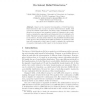Free Online Productivity Tools
i2Speak
i2Symbol
i2OCR
iTex2Img
iWeb2Print
iWeb2Shot
i2Type
iPdf2Split
iPdf2Merge
i2Bopomofo
i2Arabic
i2Style
i2Image
i2PDF
iLatex2Rtf
Sci2ools
ECSQARU
2007
Springer
2007
Springer
On Latent Belief Structures
Based on the canonical decomposition of belief functions, Smets introduced the concept of a latent belief structure (LBS). This concept is revisited in this article. The study of the combination of LBSs allows us to propose a less committed version of Dempster’s rule, resulting in a commutative, associative and idempotent rule of combination for LBSs. This latter property makes it suitable to combine non distinct bodies of evidence. A sound method based on the plausibility transformation is also given to infer decisions from LBSs. In addition, an extension of the new rule is proposed so that it may be used to optimize the combination of imperfect information with respect to the decisions inferred.
| Added | 07 Jun 2010 |
| Updated | 07 Jun 2010 |
| Type | Conference |
| Year | 2007 |
| Where | ECSQARU |
| Authors | Frédéric Pichon, Thierry Denoeux |
Comments (0)

